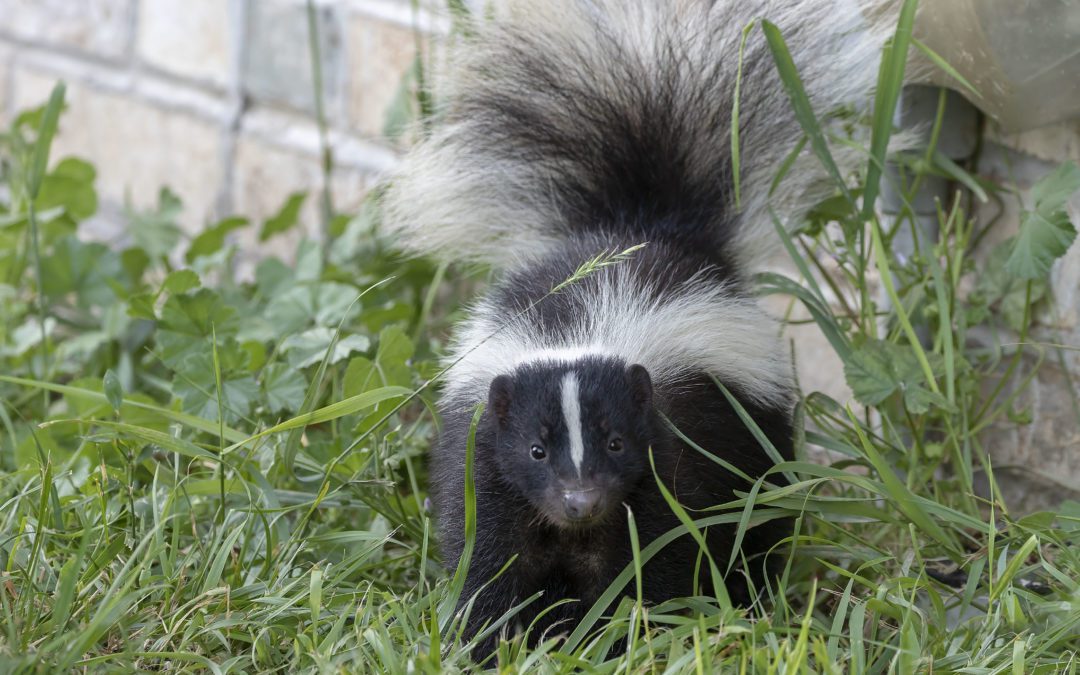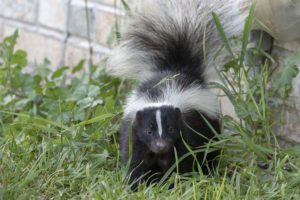Nearly everyone has had the unpleasant experience of walking or driving through an area where there is a cloud of skunk spray, and many people have suffered through skunks denning beneath their homes. Their pungent method of protection has given skunks a bad name and labeled them as a pest. We know their distinctive aroma well, but what don’t we know about these fascinating animals?
- Skunks can aim their spray – Most meat-eating mammals have anal glands for the purpose of secreting a potent, oily substance, not just skunks! These scent glands have evolved to fulfil different purposes in different mammals. For example, wolverines use theirs to mark territory, and minks use theirs as a repellant. Skunks are the only animal who use theirs as a defense mechanism. Unlike other mammals with the similar abilities, a skunk’s anal glands have evolved into two nipples that protrude out of the anus in order to spray. The skunk can manipulate its sphincter muscles in order control the direction these nipples spray, and it can adjust the consistency of the spray by making the opening of the nipples larger or smaller. If a skunk knows exactly who its threat is, it is likely to project a stream directly at its enemy’s face, but if it is unsure of who or what is pursuing it, it will spray a fine mist so that its attacker must run through a cloud of the acrid liquid in order to reach it. Skunk spray is so potent that it can induce vomiting and cause temporary blindness.
- Skunks use spray as a last resort – It is a common misconception that skunks spray all the time. They actually only use their spray as a last resort when they feel they have exhausted all of their other defense mechanisms. A skunk only holds about 4 tablespoons of its noxious fluid, and it can take several days to replenish, leaving it vulnerable in the meantime. A skunk’s distinct black and white markings are a defense in and of themselves. Animals who have been sprayed remember the experience and see the coloring as a caution sign. Because of this, skunks are used to being left alone and have few natural enemies. But when someone is bold enough to threaten them, the skunk’s first instinct is to run away. If this doesn’t work, it will turn around to face its enemy, raise its tail as a warning, and stomp its front feet. If this still isn’t effective in scaring away the attacker, the skunk will then use its spray. Of the different species, the spotted skunk has some of the most fascinating defensive behavior. Rather than simply raising its tail, it will stand on its front feet and lift its entire body into a handstand as a kind of warning signal.
- Skunks are their own animal family – For a long time, skunks’ squat body shape and long digging claws led scientists to believe that skunks were part of the weasel family. But upon further study, it was discovered that skunks are actually an entire animal family unto themselves. The 12 different species of skunk belong to the family of Mephitidae – which means “stink” – and all evolved from a common ancestor 30-40 million years ago.
- Skunks are extremely adaptable – Skunks can and will eat nearly anything, which makes it very easy for them to thrive in a variety of environments. They actually prefer areas where two different kinds of habitats meet (like a beach and a field or a marsh and a forest), because it offers them a wider range of food choices. Given the option, a skunk will eat mostly insects, and at that, they’re the kinds of insects other animals don’t want to eat. This makes them very useful in controlling nuisance insect populations like bees, wasps, and hornets as well as stinkbugs. But they have also found great success by shadowing humans and living off of trash, pet food, and grubs found in lawns, leading to large increase in the need for skunk control services over the past several years.
- Skunks and rabies – Because skunks are one of the top carriers of rabies in the nation (in Illinois, they are #1), most states have very strict laws about skunk control practices and what can and cannot be done with a captured skunk. Most states restrict owning domesticated skunks as pets, and in many places, it is illegal to release a captured skunk back into the wild. Animals cannot be born with rabies, and it is not possible to contract it through skunk spray; it is transmitted only through being bitten (saliva) or brain tissue. Since biting isn’t a common line of defense for skunks, it is thought that the disease may be so prevalent because they are susceptible to many different strains of the virus: at least four strains among the species as well as strains contracted from other mammals.
Skunks favor well-covered areas and tend to dig their dens beneath porches, sheds, and decks, so if you suspect you have one (or several) living beneath your home, it is best to keep your family and your pets away from the area until the animal has been removed by a professional. If your dog or cat has had an unfortunate encounter with a visitor in your yard, we recommend using our skunk spray removal formula to get your pet smelling fresh again. If you’re experiencing a skunk control problem on your property, don’t hesitate to call ABC Humane Wildlife Control & Prevention today. Our certified wildlife control technicians are experts in skunk removal and will know the best methods for identifying active skunk burrows, setting a humane trap to capture the animal, and evacuate it from your home.



